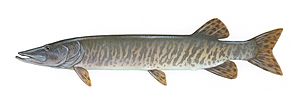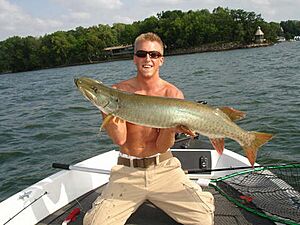Muskellunge facts for kids
The muskellunge (scientific name Esox masquinongy), often called the muskie, is a large freshwater game fish. It's the biggest member of the Esox family, which also includes pike. Muskies are native to parts of northern and eastern North America. They have also been introduced to other U.S. states. Muskies are usually found alone and are apex predators, meaning they are at the top of the food chain in their habitat. They need a lot of space to find enough food. Muskies are carnivores and eat other fish. They are also ambush feeders, attacking anything that moves in or on the water.
Contents
Types of Muskies
There are three main types, or subspecies, of muskellunge.
- The Great Lakes Muskellunge (Esox masquinongy masquinongy) lives naturally in the Great Lakes Basin.
- The Chautauqua Muskellunge (Esox masquinongy ohioinis) is found in Chautauqua Lake and areas south into Ohio.
- The Northern Muskellunge (Esox masquinongy masquinongy) is native to Michigan, Wisconsin, and Minnesota.
There is also a special kind of muskie called the Tiger muskellunge (or Tiger Muskie). This fish is a hybrid, which means it's a mix of a muskellunge and a Northern pike (Esox lucius). Tiger muskies are usually smaller than true muskies. However, they can grow up to 1.5 times faster in their first year. They are almost always sterile, meaning they cannot have babies of their own.
How to Identify a Muskie
True muskies have light-colored bodies. They can be silver, light green, or light brown. They usually have dark bars or spots on their sides. This is different from the Northern pike, which has dark bodies with light-colored bars.
Muskies also have scales only on the upper half of their cheek. The best way to tell a muskie from a northern pike is by looking at the pores (small holes) under their jaw. Northern pike have five or fewer pores, while muskies have six or more. Male muskies are always smaller than females.
Tiger muskies look like a mix of both muskies and northern pike. Their "tiger" stripes are usually much clearer than the markings on a true muskie. Tiger muskies can happen naturally where both muskies and northern pike live. However, they are never found in large numbers. Scientists began raising tiger muskies in special fish farms once they understood they were a hybrid. Male and female tiger muskies are usually about the same size.
Habitat and What They Eat
Muskies are very good predators. They often wait quietly near the shoreline in shallow water. They hide among weeds, near logs, or under rocks. In the summer, when the water gets warmer, muskies move to deeper, cooler waters. But they still stay close to shallow areas, using drop-offs for cover. Muskies can live in water as warm as 90 degrees Fahrenheit.
Muskies mainly feed on other fish, like suckers and perch. They are ambush feeders, meaning they will eat almost anything that comes close. They have even been known to eat Loons, ducks, and small mammals like Muskrats.
When the water temperature reaches about 60°F, muskies eat a lot. When it gets to 80°F, they eat less. They prefer to eat larger fish over smaller ones. Muskies strike very quickly. They often take their prey to a quiet spot before eating it. They tend to stay in the same part of a lake, sometimes for their whole lives.
Muskie Life Cycle and Behavior
Muskies are among the largest freshwater fish in North America. The biggest one ever recorded weighed almost 70 pounds! Most muskies are less than 40 inches long and weigh between 7 and 15 pounds. Muskies can live for up to 30 years.
After the ice melts on northern lakes, when the water temperature is between 49° and 59°F, muskies begin to spawn (lay eggs). In lakes where both northern pike and muskies live, muskies spawn after the northern pike. A female muskie can lay between 60,000 to 100,000 eggs.
In lakes with northern pike, fewer muskie babies (called fry) survive. There are two main reasons for this. First, northern pike hatch about two weeks earlier than muskies. This means the young northern pike can eat the smaller muskie fry. Second, young muskie fry swim just below the surface of the water. This makes them easy targets for fish below or birds flying above.
Fishing for Muskies
Muskies are hard to catch, but they are highly valued by people who fish. Many anglers (fishermen) only fish for muskies. They are sometimes called "the fish of 10,000 casts" because they are so difficult to hook. Many fishing guides say that muskies are not afraid of anything, even people. They often follow fishing lures right up to the boat without biting. Sometimes, they might even flick a lure back at the fisherman!
Hooking a muskie is tough, and landing one is even harder. They fight very hard for short periods. It's important to land them quickly to avoid stressing them too much. If a muskie fights for too long on light fishing gear, it could die even after it swims away. You need both Skill and luck to successfully land a muskie.
Anglers must handle muskies very carefully. A very large muskie is an old fish; a 30-pound female might be 17 years old. If these big fish are caught and kept, they are not easily replaced. Because of this, catch and release is strongly recommended. This means you catch the fish, take a quick picture, and then let it go unharmed. Muskies are large, powerful fish with very sharp teeth, so careful handling is a must. If they are handled carelessly, many fish might not survive after being released.
Images for kids
-
A spotted muskellunge caught in Lake St. Clair during winter.
See also
 In Spanish: Muskallonga americano para niños
In Spanish: Muskallonga americano para niños







